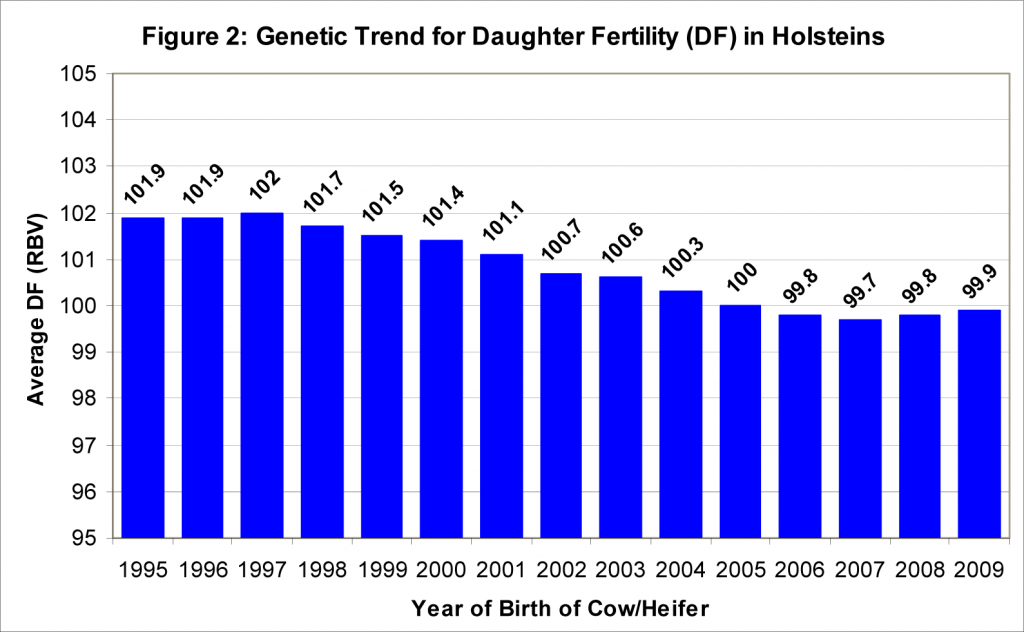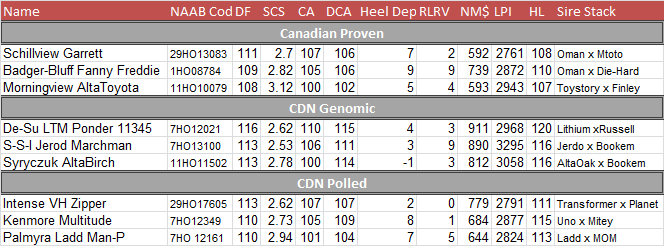Too many people say that dairy breeding is an art. If they manage their herds this way, they will be unable to compete in an industry that grows with science. Art places value on the ‘family’ and sees both parents contributing equally shared value to their offspring. In practicing the science of dairy cattle breeding parents are not equal when it comes to which one is the most important when deciding upon a herd’s genetic improvement plan (Read more: What’s the plan? And Flukes and Pukes – What Happens When You Don’t Have a Plan, and Pick The Right Bull – Your Future Depends on The Decisions You Make Today!).
3 Factors Determine Genetic Advancement
On a simplified basis, the rate of genetic advancement in a dairy herd is primarily a function of three factors: 1) the superiority of parents; 2) the accuracy of the parent’s genetic indexes and 3) the generation interval expressed as the time between the birth of the parent to the birth of the calf. Dairy cattle breeders have, in the past, placed a priority on intense selection, but today with genomic information generation interval is necessary.
Four Pathways for Improvement
In a population of dairy cattle there are four groups, commonly called transmission pathways that are considered when determining the overall population rate of improvement. These pathways are: 1) the Sires of Bulls (SB); 2) the Sires of Cows (SC); the Dams of Bulls (DB); and the Dams of Cows (DC). Breeders do not have equally accurate information on each pathway and definitely do not apply equal selection intensity for each pathway.
Which Breeding Scheme is the Best?
The following table outlines the importance of the different pathways for three improvement schemes when animals are ranked and selected using total merit indexes like TPI, NM$ and LPI.
Comparison of Genetic Improvement Schemes
| Pathway | Selection % | Accuracy | Generation Interval | Relative Emphasis |
| 1. Traditional Progeny Testing Program | ||||
| Sires of Bulls (SB) | 5 | 0.99 | 7 | 44%* |
| Sires of Cows (SC) | 20 | 0.75 | 6 | 22% |
| Dams of Bulls (DB) | 2 | 0.6 | 5 | 31% |
| Dams of Cows (DC) | 85 | 0.5 | 4.25 | 3% |
| Relative Total Merit Genetic Gain per Year = 100% | ||||
| 2. Genomic Testing Program | ||||
| Sires of Bulls (SB) | 5 | 0.75 | 1.75 | 34% |
| Sires of Cows (SC) | 20 | 0.75 | 1.75 | 23% |
| Dams of Bulls (DB) | 2 | 0.75 | 2 | 40%* |
| Dams of Cows (DC) | 85 | 0.5 | 4.25 | 3% |
| Relative Total Merit Genetic Gain per Year = 185% to 200% | ||||
| 3. Genomic Testing Program with IVF | ||||
| Sires of Bulls (SB) | 5 | 0.75 | 1.75 | 30% |
| Sires of Cows (SC) | 10 | 0.75 | 1.75 | 20% |
| Dams of Bulls (DB) | 2 | 0.75 | 2 | 36%* |
| Dams of Cows (DC) | 10 | 0.62 | 2 | 14% |
| Relative Total Merit Merit Genetic Gain per Year = 225% to 250% | ||||
* Pathway of most importance The Bullvine appreciates the assistance of Dr. Larry Schaeffer, University of Guelph, in providing information for the above table. Further details can be found in Dr. Schaeffer’s 2006 paper “Strategy for applying genomic-wide selection in dairy cattle,” Volume 123 of Journal of Animal Breeding and Genetics.
Progeny Testing has Served Breeders Well
Breeders have been successful when they used the results of the traditional A.I. progeny testing programs. That is when only elite sires are used to produce bulls (SB) for progeny testing, each year newly proven sires are used to produce the heifer calves (SC), Dams of Bulls (DB) are elite indexing milking females and the bottom 10-15% of the cows in the herd are not used to produce replacement heifers. (Read more: Why you should get rid of the bottom 10% and 8 Ways DNA PROFILING Your Whole Herd Will Improve Your Breeding Program) most important pathway, by quite a distance, is the Sires of Bulls (SB) at 44%. Combined the sire pathways (SB & SC) account for 66% of the total genetic progress. That is opposite to what many breeders say ‘Sires are not as important as cow families. The cow family, in a herd, dominates.’
Genomics gives 185 – 200%
Over the past five years, breeders have become familiar with the program whereby the genomic indexes on young animals are used for animal selection. Even though this program is much discussed, it has been implemented on less than 10% of the farms in North America. In Holsteins, less than 7% of calves registered are genomically tested. Breeders are obviously not confident with the lower accuracies and the much shorter generation intervals. So let’s dig deeper to see what the facts are when it comes to rates of genetic improvement. With the genomics program the relative importance between pathways shifts to where the Dams of Bulls (DB), at 40%, is the most important followed next by the Sires of Bulls (SB) at 34%. Again in this program, as in progeny testing, very limited selection pressure is applied to Dams of Cows (DC), pathway resulting in only 3% of the total progress. The relative ratios of improvement from sire and dam pathways is 57:43. The telltale important fact is that by using a genomic program the rate of annual genetic gain is 185% to 200% of what can be achieved by using the traditional progeny testing program. Another important difference between these two programs is that considerable money can be saved by only having to progeny test less than half as many young bulls with the genomic testing program.
Adding IVF gives 225 – 250%
Some breeders add IVF to their genomic selection program however due to costs and the challenge of mating carefully to avoid inbreeding it is not for everyone. The accuracies of this program match those of the genomic testing program, but the selection intensities are increased for the Sires of Cows (SC) pathway and greatly increased for the Dams of Cows (DC) pathway. For all pathways the generation intervals are short, something many breeders state as being a concern. These farms use IVF on maiden heifers to produce all of the next generation of animals. Again the most important pathway is the Dams of Bulls (DB) at 36%. However, the differences between emphasis on the pathways is narrowed. The ratio of emphasis sires to dams is 50:50. Farms employing this program can have annual rates of genetic gain of 225% to 250% compared to what is possible for herds using a progeny testing program. To fund this more expensive program breeders often sell surplus embryos or animals.
The Bullvine Bottom Line
Determining which parent pathway is the most important rests with which testing and selection program a breeder wants to follow. For breeders using the traditional progeny testing program by far the most important animals are the sires of the young bulls (SB) that enter A.I. progeny testing programs. For breeders wanting to advance their herds at a faster rate by using the less accurate genomic information and shorter generation intervals, the dams of the bulls (DB) is the most important pathway. No matter which program a breeder chooses it is important to have a plan and always use the best available animals.
Get original “Bullvine” content sent straight to your email inbox for free.














